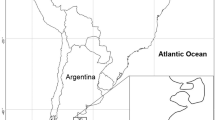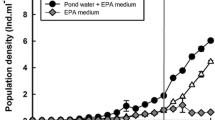Abstract
Gelidium sesquipedale fecundity was quantified by counting tetrasporangial sori and cystocarps per meter squared and by estimating the number of spores contained inside them. These were obtained by regression on a size metric of reproductive structures. Tetrasporangial sori length and cystocarp thickness were the best estimators of spore number. To assess spore recruitment, 12 pottery tiles were fixed to the bottom, and the appearance of small fronds was monitored.
No clear seasonal pattern of reproduction was found. Tetraspore production peaked in March 1990 with 10.4 × 106 spores m−2, whereas the carpospore peak was lower, 4.9 × 105 spores m−2 in July 1989. Recruitment followed tetraspore peaks. The probability of a G. sesquipedale tetraspore making the transition to a recruit was 4.7 × 10−5. Frond length was significantly related to tetrasporangial sori number, while cystocarp number was only related to frond branching order. Minimum size for reproduction was 6.9 cm for gametophytes and 5.4 cm for tetrasporophytes; very rarely were cystocarpic fronds smaller than 9 cm, while tetrasporic fronds were often longer than 15 cm. Cystocarpic fronds were significantly shorter and had more branches than tetrasporic fronds.
Similar content being viewed by others
References
Anderson, R. J., R. H. Simons, N. G. Jarman & G. J. Levitt, 1991. Gelidium pristoides in South Africa. Hydrobiologia 221: 55–66.
Ang, P. O., 1991. Age- and size-dependent growth and mortality in a population of Fucus distichus. Mar. Ecol. Prog. Ser. 78: 173–187.
Ang, P. O. & R. E. De Wreede, 1990. Matrix models for algal life history stages. Mar. Ecol. Prog. Ser. 59: 171–181.
Chapman, A. R. O., 1984. Reproduction, recruitment and mortality in two species of Laminaria in southeast Nova Scotia. J. exp. mar. Biol. Ecol. 78: 99–110.
Dixon, P. S., 1958. The structure and development of the thallus in the British species of Gelidium and Pterocladia. Ann. Bot. 22: 353–368.
Gorostiaga, J. M., 1990. Aspectos demográficos del alga roja Gelidium sequipedale (Clemente) Thuret. Discusión sobre su adequada gestión como recurso explotable. Ph. D. Dissertation, Universidad del Pais Vasco, Bilbao, Spain, 313 pp.
Guzmán del Proó, S. A., S. de la Campa de Guzmán & J. Pineda-Barrera, 1972. Shedding rhythm and germionation of spores in Gelidium robustum. Proc. int. Seaweed Symp. 7: 221–228.
Hanic, L. A. & J. Pringle, 1978. Pottery, a substrate for algal culture. Br. phycol. J. 13: 25–33.
Hawkes, M. W., 1990. Reproductive strategies. In K. M. Cole and R. G. Sheath (eds), Biology of the red algae, Cambridge University Press, Cambridge: 455–476.
Juanes J. A., B. Santelices & J. L. McLachlan (eds), 1991. International workshop on Gelidium, Kluwer Academic Publishers, London, 203 pp.
Melo, R. A. & M. Neushul, 1993. Life history and reproductive potential of the agarophyte Gelidium robustum in California. Proc. int. Seaweed Symp. 14: 223–229.
Santelices, B., 1988. Synopsis of biological data on the seaweed genera Gelidium and Pterocladia (Rhodophyta). FAO Fisheries Synopsis 145, 55 pp.
Santelices, B., 1990. Patterns of reproduction, dispersal and recruitment in seaweeds. Oceanogr. mar. Biol. Annu. Rev. 28: 177–276.
Santos, R., 1993a. A multivariate study of biotic and abiotic relationships in a subtidal algal stand. Mar. Ecol. Prog. Ser. 94: 181–190.
Santos, R., 1993b. Plucking or cutting Gelidium sesquipedale? A demographic simulation of harvest impact using a population projection matrix model. Proc. int. Seaweed Symp. 14: 269–276.
Santos, R., 1994. Frond dynamics of the commercial seaweed Gelidium sesquipedale: effects of size and of frond history. Mar. Ecol. Prog. Ser. 107: 295–305.
Santos, R., 1995. Size structure and inequality in a commercial stand of the seaweed Gelidium sesquipedale. Mar. Ecol. Prog. Ser., 119: 253–263.
Santos, R. & P. Duarte, 1991. Marine plant harvest in Portugal. J. appl. Phycol. 3: 11–18.
Santos, R., J. M. Gorostiaga, R. Armisén, J. M. Salinas & J. C. Oliveira, 1993. Gelidium sesquipedale resource management in the Northeast Atlantic. In R. Santos, Population ecology of the commercial seaweed Gelidium sesquipedale: biological input for resource management. Ph. D. Dissertation, Dalhousie University, Halifax, Canada, 149 pp.
Seoane-Campa, J., 1965. Estudios sobre las algas bentónicas en la costa sur de la Peninsula Ibérica (litoral de Cadiz). Inv. Pesq. 29: 3–216.
Seoane-Campa, J., 1969. Crecimiento, producción y desprendimiento de biomassa en Gelidium sesquipedale (Clem.) Thuret. Proc. int. Seaweed Symp. 6: 365–374.
Suto, S., 1950. Studies on a counting method of spores of seaweeds in the sea. Bull. Jap. Soc. Sci. Fish., 15: 674–677.
Author information
Authors and Affiliations
Rights and permissions
About this article
Cite this article
Santos, R., Duarte, P. Fecundity, spore recruitment and size in Gelidium sesquipedale (Gelidiales, Rhodophyta). Hydrobiologia 326, 223–228 (1996). https://doi.org/10.1007/BF00047811
Issue Date:
DOI: https://doi.org/10.1007/BF00047811




